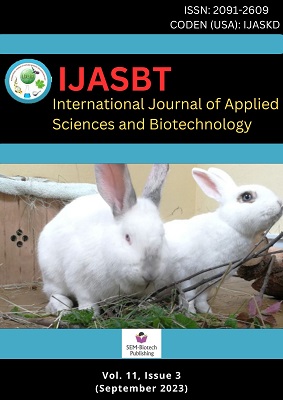Drinking Water Quality from Different Sources at Squatter Settlements of Bagmati River Corridors in Kathmandu, Nepal: An Assessment using Water Quality Index (WQI)
DOI:
https://doi.org/10.3126/ijasbt.v11i3.58962Keywords:
Kathmandu, NDWQS, Physicochemical and Microbiological parameters, Squatter settlement, Water qualityAbstract
People living in squatter settlements are more vulnerable to health hazards due to a lack of potable drinking water. The key mission of this study was to evaluate the water quality from different sources at squatter settlements of Bagmati river corridors in Kathmandu. For this, a total of 131 water samples (24 KUKL pipelines, 29 wells, 35 tube wells, 9 stone spouts, 15 tankers, and 19 jars) were collected from different communities of the settlements from December 2021 to May 2022. The water quality of these sources was assessed using physicochemical and microbiological parameters. The water quality index (WQI) was also used to classify the suitability of different water sources. The results of all parameters were compared against the safe limits of the National Drinking Water Quality Standards (NDWQS, 2005). Out of 131 water samples, 11.5%, 24.4%, 11.5%, 16.0%, 28.2%, and 16.8% exceeded the NDWQS safe limits for total dissolved solids, total hardness, chloride, ammonia, iron, and manganese respectively. Likewise, 11.5% and 31.3% of the total water samples were contaminated with fecal and total coliform respectively. Tube well source was found highly contaminated both in physicochemical and microbiological form whereas jar water demonstrated more suitability for drinking purposes. Estimated WQI values also revealed well and tube well sources as poor, KUKL pipeline, stone spout, tanker sources as good, and jar as an excellent class of water. Since most of the water sources in this study were polluted, the implementation of appropriate water treatment processes as well as regular monitoring of water sources are strongly recommended.
Int. J. Appl. Sci. Biotechnol. Vol 11(3): 158-170.
Downloads
Downloads
Published
How to Cite
Issue
Section
License
Copyright (c) 2023 International Journal of Applied Sciences and Biotechnology

This work is licensed under a Creative Commons Attribution-NonCommercial 4.0 International License.




